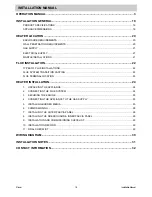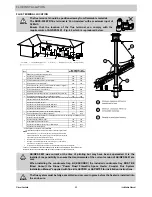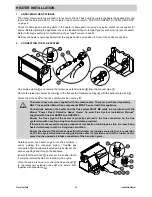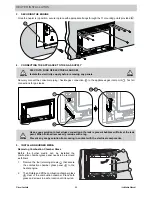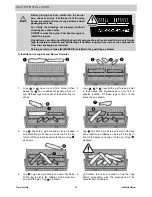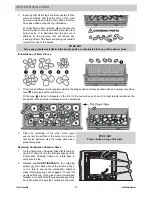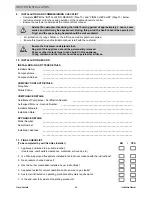
Rinnai Australia
20
Installation Manual
HEATER LOCATION
When positioning the heater the main variables governing the location are Flueing and Warm Air Distribution.
This heater must not be installed where curtains or other combustible materials could come into contact with it. In
some cases curtains may need restraining.
ENCLOSURE REQUIREMENTS
The Rinnai RHFE-950ETR has a cool outer casing allowing it to be installed into existing Masonry fireplace or into
a decorative fireplace constructed from combustible materials such as wood or plaster.
A pair of wheels located at the rear the heater allows
it to slide in and out of the enclosure for ease of
commissioning and maintenance. As such the
heater must be positioned on a flat and level surface
that allows free movement.
In a masonry fireplace, use a slurry of sand and
cement to level the base as required.
In a decorative fireplace, if the appliance is elevated
from the ground, a base must be constructed using
a board with supporting joists as shown.
WALL PENETRATION REQUIREMENTS
Mark the location of the gas supply (consumer piping) and flue pipe
penetrations from the centreline
of the heater enclosure using the
following dimensions:
Consideration must be given to the position of any studs, noggins or other
components of the wall structure.
For all installations, ONLY Rinnai ASP & ES Flue components MUST BE used. The Rinnai RHFE-
950ETR MUST NOT be flued into ‘natural draft’ flue system or via a chimney.
Consult the Rinnai “Power Flued Flamefire Space Heater Co-axial Flue System Installation
Manual” supplied with flue kits ASPDFK or ASPKIT03 for detailed flue installation instructions.
Enclosure Dimensions
Width
980 mm
Height
580 mm
Depth
570 mm (minimum)
The enclosure dimensions specified are critical to the
successful installation of this appliance and must be
strictly adhered to.
Centreline of enclosure
420 mm left of centreline
65 mm from base of enclosure
430 mm right of centreline
500 mm from base of enclosure plus or minus 25mm
Ensure the penetration points are marked accurately as this is critical for successful appliance
installation.
The penetration for the flue pipe only needs to be made for ‘Direct’ flue installations, where the
flue terminal is located directly to the rear of the appliance.
If no flue pipe penetration is required the markings are still useful for indicating the correct
position of the flue transition within the enclosure for extended horizontal flue applications.
WARNING
JOIST
JOIST
MDF (Customwood) BOARD, Minimum 20mm
850
RIGHT
WHEEL
LEFT
WHEEL
RIGHT
WHEEL
LEFT
WHEEL
w
d
h
w
h
d
NOTE
Ø 100
5
4
1
2
3
Gas supply penetration
Flue pipe penetration
1
1
2
4
5
NOTE













